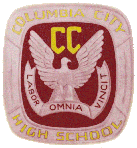Columbia City High School (260) 244-6136, Ext. 3227 |
|
Bill Jones' Photos to Smithsonian
The Post &
Mail October 12, 2006:
Snapshots of history Jones' aerial photos of Hiroshima, Nagasaki wind up in Smithsonian By Kelley Sheiss They say a picture is worth a thousand words. In the case of local resident Bill Jones’ photos, the Smithsonian Institution in Washington, D.C. realized the historical value of his photography work captured during World War II. Columbia City WWII aerial photographer and curator of the Hoosier Air Museum, Bill Jones now has his Hiroshima and Nagasaki low altitude photos in the Smithsonian Institution National Air & Space Museum Archives. Jones was in Washington D.C. in mid-August and met with the Smithsonian’s acquisition archivist and chief photo archivist. After evaluating his photographs, a request was made to borrow and scan the negatives which Jones had with him. This is quite an honor for the 80-year-old WWII veteran, who kept the photos under wraps for 40 years. Jones never showed the pictures to anyone, as they were never declassified. However, after a chance correspondence with the pilot of the legendary Enola Gay, Jones was given permission to release the photos, coinciding with the 45th anniversary of the event. At the time of the photo release, he was able to meet with the mission’s pilot, bombardier and navigator, all of whom signed one of the photos. Talking with Bill Jones is like taking a wonderfully interesting history class. A native of Starke County, Ind., Jones settled in Columbia City with his family when he was in the second grade. He attended the McClellan School. He always had a passion for airplanes, driving his decision to join the Civil Air Patrol in 1943 and take pilot training at Baer Field in 1944. Several bouts with rheumatic fever as a youth kept his weight below the requirement to become a pilot in the Air Force. However, in 1944 Jones was drafted and entered the Army Air Corps. His desire to fly never faltered. He spent six months in photography school in Colorado and then specialized in aerial photography with B-17 aircraft. During the occupation of Japan, Jones was afforded the opportunity to capture the atomic bomb damage of Hiroshima and Nagasaki. Upon arriving in Hiroshima, he noticed there was no crater left from the bomb, however almost everything was gone. Everything, that is, except for a railroad engine, cab first, in the ground. Jones explained that the bomb exploded at 1,800 feet and the pressure from the bomb would cause a two-mile path of destruction. Heat at 5,400 degrees in an instant virtually vaporized everything. Jones highlights the bomb’s hypocenter on the picture, which is the point under which a nuclear blast occurs. After the Air Force, Jones served a four-year General Electric machinist-toolmaker apprenticeship and took college classes in the evening. He owned and operated his studio, Jones Photo, in Columbia City for 43 years. His ingenuity served him well in the photography business, as Jones’ developed some of his own equipment, building an electronic flash at a time when no one else had it. Jones is also active in the Air Force Association, Hoosier Warbirds, United States Air Force Auxiliary and Drug Free Indiana. Though retired, Jones has not slowed down through the years. He enjoys the opportunity to keep busy and share his love of planes and photography with others. In addition to the Smithsonian, Jones’ photos are in most of the atomic museums and many of the major air museums throughout the country. The closest location where the photos and other atomic bomb related materials can be seen is at the Hoosier Air Museum located on the south side of the DeKalb County Airport. Jones can also add “actor” to his list of credentials. His photography and piloting expertise have landed him roles in several Windsong Pictures films, the most recent to be released in the spring of 2007. Jones enjoys sharing his experiences and is available to speak to a wide variety of groups. He has a PowerPoint program which he has presented more than 245 times to schools, service clubs, aviation groups and churches in Indiana, Ohio and Michigan. There is no charge for the program. On Nov. 8, Jones is scheduled to present at the Senior Citizens Center in Columbia City at 11 a.m. In all of his life experiences, Bill Jones notes that he was proud to be able to preserve for posterity the number one news event in the 20th Century. Currently residing in Columbia City, Jones is planning to relocate to Huntington in November. He has many good friends in the area and plans to stay in touch with the local community. To contact Jones for a program or more information on the Hoosier Air Museum, write to: Bill Jones, 1570 North Lafontaine, Huntington, IN 46750-1308 or call (260) 414-5648. |
|
©2005 Columbia City High School Alumni Association. This page last updated 08/06/2012 |

